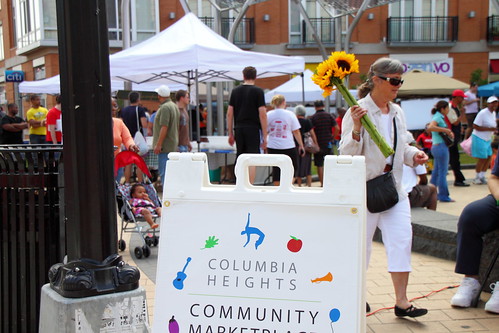
Nutritional classes, purple beets, basil pesto and dark roast coffee - it’s not your father’s farmers market. The entire local food system is maturing and farmers markets are offering more and more community-focused services. Many farmers markets now give their customers a chance to learn about locally-produced foods, in addition to buying and consuming them.
USDA is a proud partner and supporter of local and regional food systems through our programs, grants and technical services. USDA’s Agricultural Marketing Service (AMS) grants are helping farmers markets implement creative programs to support local food producers and build healthy communities. One example of an AMS grant success story is Community Foodworks, which manages the Columbia Heights Farmers Market and six other markets across Washington, DC, and Northern Virginia.
Leveraging a Farmers Market Promotion Program grant, Foodworks established a new Wednesday evening farmers market to increase access to locally produced food in the Columbia Heights neighborhood. The program included “Bonus Bucks” to give shoppers who use Federal food benefits (SNAP, WIC, Senior FMNP) more purchasing power.
The grant also helped Foodworks to develop a mixed-income CSA program – a weekly share from the market’s producers with options for individual or family-sized shares or a subsidized family-sized share for SNAP customers. The new market had a real impact on the community:
- Over half of the customers reported eating more vegetables since the market opened (54 percent)
- A majority of market visitors reported the Bonus Bucks program was the main reason they shopped at the market (72 percent)
- Most customers agreed that spending their benefits at the market was easy (89 percent)
In addition to their farmers market efforts, Foodworks offers other creative programs to help support the community. In partnership with another local social service organization, Foodworks is able to provide fresh, local food home delivery services for seniors. They serve as a site for USDA summer meals, distributing 3-4 dozen snacks to hungry children at their two weekday markets. They also offer community educational classes on nutrition, obesity, and diabetes intervention. In the fall of 2015, Foodworks piloted a new Veterans Vegetable Prescription Program to distribute weekly fruit and vegetable vouchers to eligible Veterans, seeing a redemption rate of 42 percent.
These are great innovations and partnerships leveraged by Foodworks. As we continue to support the marketing and distribution of locally produced foods for U.S. farmers and ranchers, we look to see more impacts resulting from our investments. Under this Administration, USDA has invested more than $1 billion in over 40,000 local and regional food businesses and infrastructure projects.
These activities contribute to USDA’s Know Your Farmer, Know Your Food (KYF2) initiative, which coordinates efforts across USDA. Our recently-revamped website provides USDA resources for every point in the local food supply chain, including grants, loans, and other instructional guides. Additionally, the KYF2 Compass maps local and regional food system investments across the country.
More information on how USDA investments are connecting producers with consumers and expanding rural economic opportunities is available in Chapter IV of USDA Results on Medium.

